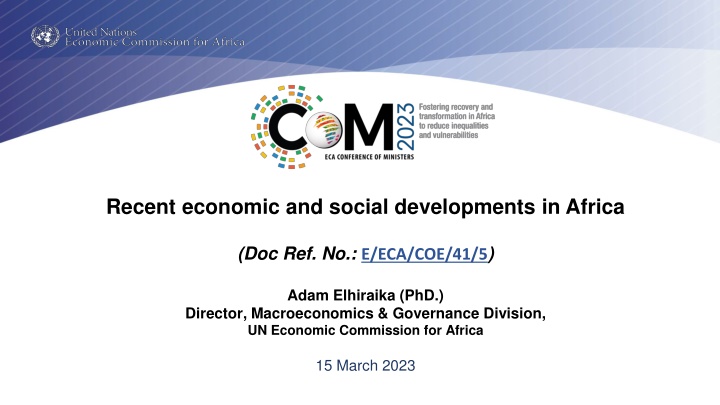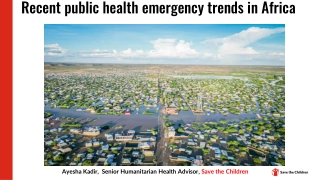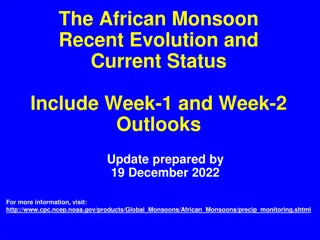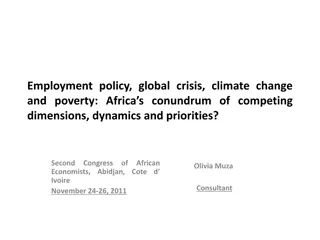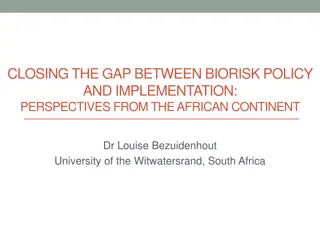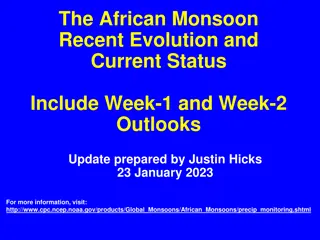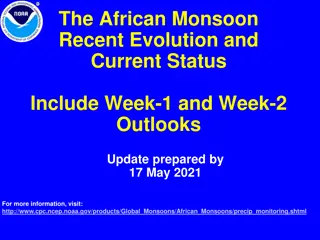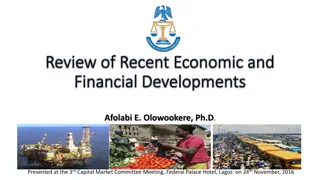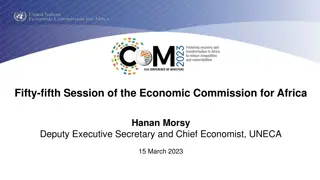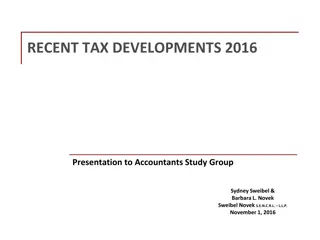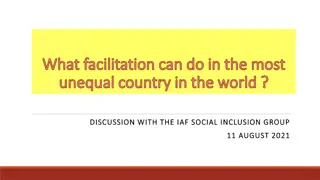Recent economic and social developments in Africa
Economic and social insights on Africa's growth, debt distress, inflation, and poverty trends in 2022-2023. Analysis of fiscal deficits, GDP growth drivers, and fiscal balance projections for African subregions.
Download Presentation

Please find below an Image/Link to download the presentation.
The content on the website is provided AS IS for your information and personal use only. It may not be sold, licensed, or shared on other websites without obtaining consent from the author.If you encounter any issues during the download, it is possible that the publisher has removed the file from their server.
You are allowed to download the files provided on this website for personal or commercial use, subject to the condition that they are used lawfully. All files are the property of their respective owners.
The content on the website is provided AS IS for your information and personal use only. It may not be sold, licensed, or shared on other websites without obtaining consent from the author.
E N D
Presentation Transcript
Recent economic and social developments in Africa (Doc Ref. No.: E/ECA/COE/41/5) Adam Elhiraika (PhD.) Director, Macroeconomics & Governance Division, UN Economic Commission for Africa 15 March 2023
Key Messages 22 22 In 2022, 8 African countries were in debt distress and 13 at high risk of debt distress - -4.8 4.8percent High fiscal deficit makes it difficult to build resilience and tackle multiple shocks but is expected to narrow to -4.8% in 2023. Title 3.9 3.9percent Africa s growth expected to rebound to 4.1% in 2023, despite being the negative impact of COVID-19 and the Ukrainian war percent percent 12 12percent Inflation remained elevated in 2022, but expected to ease to 12 percent in 2023 18 18million 18 million more people fell into poverty in 2022 as COVID-19, Ukraine war, and climate change lock millions of poor people in vulnerable situations. 144 144 million 144 million non-poor were at high risk of falling into poverty, implying that 10% of Africa s total population were vulnerable to falling into poverty percent million million
The slowdown in the global economy, high prices fuelled by The Ukrainian conflict, climate change and worsening international economic and financial conditions significantly impacted Africa s growth in 2022. Title Real growth of gross domestic product in developing regions, 2020 2023 o GDP growth declined from 4.6% in 2021 to 3.6% in 2022, but is expected to rebound to 3.9% in 2023. 10 8 6 3.6 Percentage points 4 3.9 4.6 2 o Africa was the fastest growing region after East and South Asia (4.5%), followed by South- Eastern Europe (3.2%), and Latin America and the Caribbean (2.1%) in the developing world. 0 -2 -1.8 -4 -6 -8 -10 2020 2021 2022 2023 o Mainly driven by growth in its East, North and West Africa subregions. Developing economies East and South Asia South-Eastern Europe Africa Latin America and the Caribbean Source: UNDESA 2022 and ECA estimates and forecasts, 2022
Private consumption and gross fixed investment have been the key drivers of growth in 2022. Contribution of various components to economic growth in Africa, 2019 2023 8 6 4.6 Percentage points 4 3.9 3.6 2.8 2 0 -1.8 -2 -4 2019 2020 2021 Years 2022 2023 Private consumption Gross fixed investment Government consumption Net exports GDP growth (%) Source: Based on data from EIU, UNDESA and ECA
Fiscal space remains constrained despite narrowing fiscal deficits and declining debt levels in most countries Fiscal balance for African subregions and country groups, 2019 2023 4 2 o Fiscal deficits and debt levels are projected to improve in 2023, but they remain relatively higher or at par with pre-pandemic levels in most countries (except in Central & Southern Africa which have had significant improvements). 0 Percent of GDP -2 -4 -6 -8 -10 Africa North Africa Central Africa East Africa West Africa Southern Africa Oil exporting Oil importing 2020 2021 2022 2023 2019 Gross Government Debt for African subregions and country groups, 2019 2023 o Making it harder for most countries to invest in measures to ensure resilience from shocks. 90 80 70 Percent of GDP 60 50 40 o Africa s debt-to-GDP ratio is estimated to reach 61.9% in 2023. 30 20 10 0 Africa North Africa Central Africa East Africa West Africa South Africa Oil exporting countries Oil importing countries 2020 2021 2022 2023 2019 Source: IMF, 2022, WEO October 2022
Inflation expected to decline as countries tighten their monetary policy Title Inflation rate in selected African countries, 2022-2025 35 Inflation is estimated to reach 12.8% in 2022, before declining to 12% in 2023 as monetary policy continues to tighten across the continent. 30 25 Percent (%) 20 15 However, costs and debt service burdens pose a significant challenge going forward. rising borrowing 10 5 0 2022 2023 2024 2025 Source: IMF, 2022, WEO October 2022
Further currency depreciation expected as developed countries tighten their monetary policy to contain inflationary pressures Percentage change in exchange rate (local currency against US$), 2020-2022 Currency depreciation has been more pronounced in countries with flexible exchange rate regimes and in commodity-exporting countries. 120 118 Percentage change (local currency vs US$) 110 2020-2021 Jan-Nov 2022 100 90 Depreciation 80 70 60 56 50 40 30 20 13 13 13 10 11 11 11 8 0 1 1 1 0 -2 -10 Countries with fixed exchange rates, especially those within CEMAC and WAEMU, experienced an average depreciation of 10% against the US dollar in 2022. -20 Ghana Algeria Botswana Mauritius CEMAC Egypt Seychelles Nigeria Namibia WAEMU Tanzania, United Rep. of South Africa Cabo Verde Congo, Dem. Rep. of the Oil exporter Other resource intensive Tourism dependent Monetary Unions Source: Based on data from the IMF International Financial Statistics and Bloomberg databases, 2022.
Despite its rebound after the pandemic, Africas share in global trade exports remains small, at 2.5% in 2021. Title Total African Trade (billions), 2016-2021 and Growth Rate (percent) YOY (Right Axis) o After a decline of 18% in 2020 due to the COVID-19 pandemic, African trade rebounded in 2021, increasing by 34%. $1,400 40% Billions $1,200 30% $1,000 20% $800 10% o Although the recovery of Africa s exports outpaced the rest of the world, (growing at 42% in 2021), its share of total exports remains small. $600 0% $400 -10% $200 -20% $- -30% 2016 2017 2018 2019 2020 2021 Growth Rate YOY Source: Data from UNCTADStat Database, Accessed 1 December 2022
The AfCFTA is expected to significantly increase Intra-African trade Distribution of absolute gains by main sectors in African countries exports to Africa with the AfCFTA implemented (compared to the absence of the AfCFTA) - 2045 oAfCFTA is estimated to increase intra- African trade by around 35 percent by 2045, benefiting all sectors. 100% 80% 60% 40% 20% oIntra-African trade in agrifood, services, and industry expected to increase by around 40%. 0% Services Industry Energy/Mining Agrifood Source: ECA&CIREM-CEPII s calculations based on MIRAGE-e, 2021.
Rising poverty levels with more people being at risk of falling into poverty Poverty levels in Africa (number of people), 2019-2022 590 578 580 570 oWhile the number of poor people in Africa declined between 2020 and 2021, it rose again by 18 million between 2021 and 2022, with 545 million people living in poverty. 560 545 In millions 550 540 527 530 516 520 510 500 490 480 2019 2020 2021 2022 Source: ECA computations based on World Bank (2022) o144 million non-poor were at high risk of falling into poverty, implying that 10 percent of Africa s population were vulnerable to fall into poverty in 2022. Number of people (millions) 20% above the poverty line and vulnerable to fall into poverty in 2022 160 144 140 120 100 Million 80 52 48 60 28 40 16 20 5 0 Africa West Africa East Africa Central Africa North Africa Southern Africa
Policy recommendations African governments need to design and implement credible macroeconomic frameworks to build production capacity and enhance value addition and job creation and structural transformation. Mobilize domestic resources through effective tax policies and the use of other innovative mechanisms and instruments, including financial flows from carbon markets and stimulate private sector investment. Develop their domestic financial markets with sound and effective regulatory frameworks and regional depth. Effective coordination between monetary and fiscal policy is critical to reduce inflation while shielding the most vulnerable households. The current international financial architecture needs to be reformed to enable African countries gain access to resources more easily and at a lower cost. Take advantage of the AfCFTA to accelerate industrialization and diversification
THANK YOU! Follow the conversation: #COM2023 More: www.uneca.org/cfm2023
